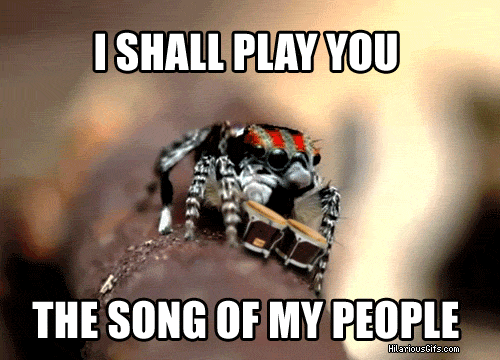Fine, fine, ok you win. The take over, if it ever happens is still a long way off. However, what this little invention does represent is the best robotic model of a spider's movement I've seen to date. Not only does the robot move with the appropriate leg pattern, but it even tilts and rotates properly. While it is very fragile still, the potential applications for this device are pretty astounding, especially for out reach purposes. A bit of paint, some plastic eyes to cover the admittedly cool monocular "eye," and you'd have quite the handy tool for teaching. I wonder if we could get some gecko tape for the feet... hmmm...
A Blog about jumping spiders for all those who are curious, afraid or just plain interested in these fascinating little predators.
18 December 2013
Robotic Salticids are taking over the world!
Well, ok maybe not so much... yet. However, the ground work has been laid! This stunning little piece of technology has me completely flabbergasted
with its realistic motion and definitely wishing I had a LOT more
disposable income. Take a look at the video below for a really nice demonstration by MythBuster's Adam Savage. If you'd rather skip most of the technical talk, jump to ~6:00 into the movie, though the whole thing is definitely worth watching.
Fine, fine, ok you win. The take over, if it ever happens is still a long way off. However, what this little invention does represent is the best robotic model of a spider's movement I've seen to date. Not only does the robot move with the appropriate leg pattern, but it even tilts and rotates properly. While it is very fragile still, the potential applications for this device are pretty astounding, especially for out reach purposes. A bit of paint, some plastic eyes to cover the admittedly cool monocular "eye," and you'd have quite the handy tool for teaching. I wonder if we could get some gecko tape for the feet... hmmm...
Fine, fine, ok you win. The take over, if it ever happens is still a long way off. However, what this little invention does represent is the best robotic model of a spider's movement I've seen to date. Not only does the robot move with the appropriate leg pattern, but it even tilts and rotates properly. While it is very fragile still, the potential applications for this device are pretty astounding, especially for out reach purposes. A bit of paint, some plastic eyes to cover the admittedly cool monocular "eye," and you'd have quite the handy tool for teaching. I wonder if we could get some gecko tape for the feet... hmmm...
24 October 2013
Just how big is salticid?
The question du Jour is "Just how big is a salticid?" and to answer that we will require some background info first. Salticids come in a wide variety of sizes, however, modern salticids are very small compared to many other spiders. Why these size constraints exist has never been examined to the best of my knowledge, though I would suspect it's due to a combination of phylogenetic inertia (i.e. they've always been small) and the fact that most of them feed on very small prey items, making a larger size impractical from a foraging perspective. Just think, if salticids were the size of small dogs like dachshunds, who would be on the menu then...
In reality, most adult salticids fall between 1mm and 22mm in length, with most being less than 10mm in my experience. However, as you can see below, juveniles can be significantly smaller.
On the other end of the scale is this giant male, who is identified by the videographer as Hyllus diardi, though I cannot confirm this. The bad news is that he is a living nightmare for those of you who are even slightly arachnophobic. The good news? He seems very friendly! If you'd like to see the original video, it and a few others can be found on youtube here.
Having now seen the full breadth of salticid size, I will leave you with these two beautiful photos of some lovely little spiders.
Happy Spidering!
 |
| Can I come over for dinner? |
In reality, most adult salticids fall between 1mm and 22mm in length, with most being less than 10mm in my experience. However, as you can see below, juveniles can be significantly smaller.
 |
| A juvenile salticid sitting on the head of an American penny. |
On the other end of the scale is this giant male, who is identified by the videographer as Hyllus diardi, though I cannot confirm this. The bad news is that he is a living nightmare for those of you who are even slightly arachnophobic. The good news? He seems very friendly! If you'd like to see the original video, it and a few others can be found on youtube here.
Having now seen the full breadth of salticid size, I will leave you with these two beautiful photos of some lovely little spiders.
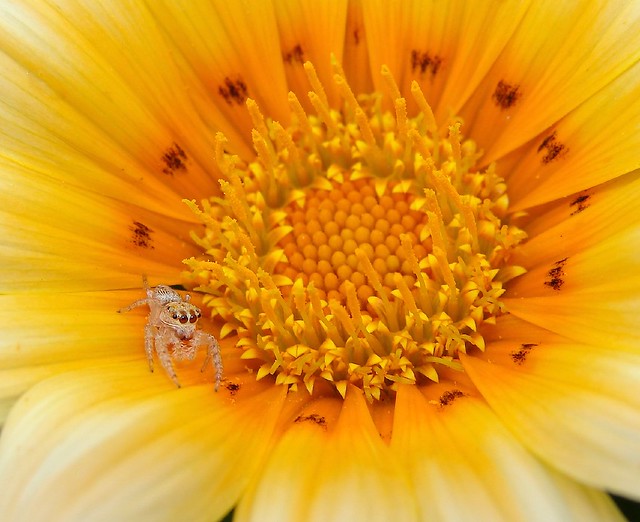 |
| Not the smallest, but by no means a giant either. And yes, those are pollen grains you're seeing next to it. Also, my apologies to the original photographer, but I seemed to have lost the attribution information... |
 |
| Its so TEENY! |
Happy Spidering!
13 September 2013
Macro-tacular Salticids
Today's long-delayed post is nothing short of a shameless excuse to peruse some of the best Macro-photography on Salticids present on the web. I will take you on a guided tour of some of the best shots I know of and hopefully even help identify some of what your looking at in the photos. After all, knowledge only makes things more appealing and interesting! Just by way of disclaimer, none of the following images are mine, and the species labels, while educated guesses, should not be treated a positive identifications as the specimen was not available for me to key out properly.
Our first photo is a lovely close up of a Phidippus species. This specimen is likely from the species P. mystaceus, given the extremely large black tufts around the eyes and the bright yellow legs.
 |
| Borrowed from http://25.media.tumblr.com/tumblr_lvys4wWKLO1r3p20do1_500.jpg |
Our next lovely model is almost certainly from the genus Lysomannes as there are very few other salticids with such a bright green complexion.These tiny salticids are known for their ability to jump very well (even for a salticid) and frequently catch flying prey by pouncing on it mid-air as it flies by!
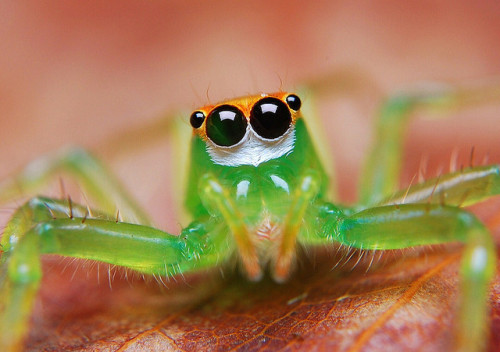 |
| Borrowed from http://24.media.tumblr.com/tumblr_mc8xsb5Oo51rob773o1_500.jpg |
This lovely ant is... wait a minute, that's no ant, its a salticid in disguise! If you take a very close look, you can see the telltale signs that we have a myrmecomorph (ant-mimicking spider) on our hands! While I am unsure as to the species, or even the Genus of the animal, I think we can all agree that it does a remarkable job of looking like its intended victims. Many species that adopt this form of mimicry feed on ants and even live in the nests of those they hunt. However, there are also mimics that only use the ants for protection and either steal food from them or else specialize in foraging near ant lines and colonies. A fascinating way to outsmart one of the salticids most dangerous enemies!
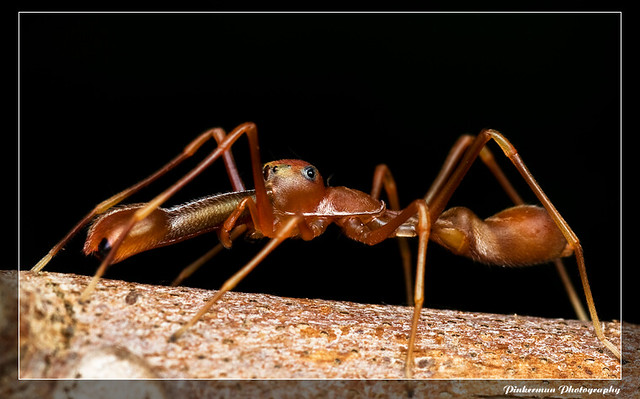 |
| Borrowed from http://farm5.staticflickr.com/4149/5050635255_aa3abe82a8_z.jpg |
Our final red-faced friend is from the Genus Habronattus. The photographer has identified the animal as H. americanus. Habronattus are generally tiny animals and are frequently no more than a few millimeters in length. They are also quite adept at jumping, much more so than this counterparts in the genus Phidippus.
 |
| Borrowed from http://bugs.adrianthysse.com/wp-content/uploads/2013/08/Habronattus-americanus-21-04-2013-5-31-36-PM.jpg |
I hope you've enjoyed this brief macro tour of salticids. For the next post, I'm planning something a bit more meaty in terms of content, but every so often its nice to have fun with these beautiful animals. As the Summer draws to a close, I encourage you to go out and enjoy these amazing little animals one last time before winter sends them scurrying for a long, and undoubtedly well deserved, nap.Happy watching!
30 July 2013
Spider Documentary
Greetings Dear Reader!
Today's post will be a brief one, and possibly slightly off topic as well. I just found out about a National Geographic documentary on spiders. Having watched it in its entirety last night, I can say that it is well worth watching, especially if you can ignore the overly dramatic music. Unfortunately, it does not focus exclusively on jumping spiders. However, it does have a nice segment on salticids and even features a few well respected researchers, such a Beth Jakobs, whose publications are well worth your time. Happy watching!
Today's post will be a brief one, and possibly slightly off topic as well. I just found out about a National Geographic documentary on spiders. Having watched it in its entirety last night, I can say that it is well worth watching, especially if you can ignore the overly dramatic music. Unfortunately, it does not focus exclusively on jumping spiders. However, it does have a nice segment on salticids and even features a few well respected researchers, such a Beth Jakobs, whose publications are well worth your time. Happy watching!
11 July 2013
Spotlight on the species Salticus scenicus
Hello dear reader and welcome to another Spotlight post! This time we place our spotlight squarely on the "Zebra Jumping Spider," Salticus scenicus.
This tiny jumping spider is only 5-7mm long and commonly found across in North America and parts of Europe. Characterized by its bold black and white stripped abdomen, this tiny spider portrays a comic personality to many observers thanks to its curiosity and tendency to look up at its viewers.
Another interesting aspect to this species is the cheliceral sexual dimorphism. Whoa, ok wait, lets back that up. For our newer readers, chelicerae are the spider's mouth parts that most people incorrectly call the fangs. I say incorrectly because on most spiders, the fangs are tiny and tucked into the chelicerae. I've added a grey arrow to the picture below to indicate the chelicerae, and a green arrow in the following photo to indicate the fangs.
This tiny jumping spider is only 5-7mm long and commonly found across in North America and parts of Europe. Characterized by its bold black and white stripped abdomen, this tiny spider portrays a comic personality to many observers thanks to its curiosity and tendency to look up at its viewers.
 |
| A female Salticus scenicus intently focused on a nearby object. |
Unlike many salticids, this species is very commonly found in urban areas, especially on the sides of buildings and window screens. They are also unusually tolerant of other salticids. Most salticids stay as far away from each other as possible unless they are looking for mates. S. scenicus, however, seems to thrive in very dense populations and can often be found within only a few centimeters of each other. Out here in the Midwestern USA, I frequently find this species in groups of 4 or more within only 2-3 square meters. While this may not seem that impressive, members of the genus Phidippus (our previous spotlight animals) are rarely found in densities greater than one or two per building face, much less several on the same side of the building.
 |
| A Male Salticus scenicus showing off his extra large chelicerae, indicated by the grey arrow. |
 |
| The same male S. scenicus with his fangs (green arrow) unfolded from his chelicera. |
The second thing I should explain is sexual dimorphism. All that fancy
term means is that the males and females of a species look different
from each other. Sometimes this difference is very drastic, as is the
case in many birds. Other times, the difference is much more subtle,
like in S. scenicus. The most obvious difference between the
males and females of this species are the greatly enlarged chelicerae and fangs of
the males, as is shown above. Obviously, S. scenicus is the exception to the rule of tiny fangs, but for a good reason! The males of this species use their enlarged mouthparts in male-male combat when they are sparring over access to females during the breeding season. In spite of these over-sized fangs and chelicerae, the species as a whole is quite timid and will usually run and hid if you attempt to do anything other than look at them.
There is a lot we can learn from this tiny species, especially given how readily they've adapted to cohabitation with people. The next time you're outside and its a nice warm day, take a look around and maybe you'll be graced by the presence of one of these tiny little hunters. Who knows, it may even be clearing out your local mosquito population for you too!
12 April 2013
Science Summarized! Are 2 heads are better than one for prey trying to escape salticids? (Sourakov 2013)
This first post of our new Science Summarized feature will be a bit unique from our future posts in the series. While it is about salticids, they are not the main focus, but rather convenient predators used in this paper.
"Two heads are better than one: false head allows Calycopis cecrops (Lycaenidae) to escape predation by a Jumping spider, Phidippus pulcherrimus (Salticidae) is a recent paper by Andrei Sourakov (2013). Published in the Journal of Natural History, this paper focuses on the butterfly subfamily Theclinae, which are commonly known as the "Hairstreak" butterflies.
These butterflies are known for both the thin white stripes on the underside of the abdomen that give them their common name, and the "false heads" on the abdomen. Unlike many lepidopterans (moths and butterflies) which freeze when approached by a predator, hairstreaks display an interesting vertical motion ("bouncing up and down") of the hind-wings when approached by a predator. Sourakov hypothesizes that this behavior, and the coloration of the abdomen, combine to provide an effective anti-predator deterrent. To test this hypothesis, Sourakov collected a local predator, Phidippus pulcherrimus, and presented it with a variety of lepidopteran prey items.
Of the 12 species tested, only Calycopis cecrops successfully evaded capture every time. Sourakov ascribes this successful evasion of spidery death to the unique behavior of C. cecrops described earlier. Sourakov also suggests that had the spider managed to successfully attack and latch onto C. cecrops, the butterfly still would have been likely to escape. According to Sourakov, the escape would be facilitated by a thinning of the hind-wings near the false head region that would have allowed the section to break off of the butterfly and leave the spider with a mouthful of wing parts.
While the conclusions drawn from this study are both interesting and plausible, there are two major flaws with the work that cannot be overlooked. First and foremost, the author only tested 15 butterflies total (one of each species with three exceptions that had two animals tested). In other words, the escapes by C. cecrops individuals tested could easily have been either flukes or traits unique to those individuals. To be convincing, I would have much preferred to see at least 30-40 individuals tested per species, and ideally many more than that given the abundance of these animals.
The second, and equally egregious, flaw was that only a single specimen of Phidippus pulcherrimus was used to test all of the butterflies. Given my own research experience with animals of this genus (Phidippus), as well as the work produced by other salticid researchers, I can say with absolute certainty that this animal is not representative of its species, let alone its genus or family. Why? Let's put it this way, in my own experiments I have found salticids to be as behaviorally variable as humans. In other words, if allowed to attack a prey item, some animals will fail over and over and over again, while other will succeed first time, every time. To imply that there is no behavioral variation in these animals, which is what Sourakv has done, is roughly equivalent to saying that North Americans all have the same political views because we are all Americans.
While I had high hopes for this paper, I am saddened to say that the study, as published, was quite a let down. The hypothesis Sourakov proposes has strong merit, and in spite of the lack of evidence presented, I for one believe it could be successfully demonstrated with some more effort. I fervently hope that future work in this area will be more scientifically rigorous.
"Two heads are better than one: false head allows Calycopis cecrops (Lycaenidae) to escape predation by a Jumping spider, Phidippus pulcherrimus (Salticidae) is a recent paper by Andrei Sourakov (2013). Published in the Journal of Natural History, this paper focuses on the butterfly subfamily Theclinae, which are commonly known as the "Hairstreak" butterflies.
 | |
| The prey, Calycopis cecrops. Borrowed from Bugguide.net |
These butterflies are known for both the thin white stripes on the underside of the abdomen that give them their common name, and the "false heads" on the abdomen. Unlike many lepidopterans (moths and butterflies) which freeze when approached by a predator, hairstreaks display an interesting vertical motion ("bouncing up and down") of the hind-wings when approached by a predator. Sourakov hypothesizes that this behavior, and the coloration of the abdomen, combine to provide an effective anti-predator deterrent. To test this hypothesis, Sourakov collected a local predator, Phidippus pulcherrimus, and presented it with a variety of lepidopteran prey items.
 |
| The predator, Phidippus pulcherrimus. Borrowed from bugguide.net |
Of the 12 species tested, only Calycopis cecrops successfully evaded capture every time. Sourakov ascribes this successful evasion of spidery death to the unique behavior of C. cecrops described earlier. Sourakov also suggests that had the spider managed to successfully attack and latch onto C. cecrops, the butterfly still would have been likely to escape. According to Sourakov, the escape would be facilitated by a thinning of the hind-wings near the false head region that would have allowed the section to break off of the butterfly and leave the spider with a mouthful of wing parts.
While the conclusions drawn from this study are both interesting and plausible, there are two major flaws with the work that cannot be overlooked. First and foremost, the author only tested 15 butterflies total (one of each species with three exceptions that had two animals tested). In other words, the escapes by C. cecrops individuals tested could easily have been either flukes or traits unique to those individuals. To be convincing, I would have much preferred to see at least 30-40 individuals tested per species, and ideally many more than that given the abundance of these animals.
The second, and equally egregious, flaw was that only a single specimen of Phidippus pulcherrimus was used to test all of the butterflies. Given my own research experience with animals of this genus (Phidippus), as well as the work produced by other salticid researchers, I can say with absolute certainty that this animal is not representative of its species, let alone its genus or family. Why? Let's put it this way, in my own experiments I have found salticids to be as behaviorally variable as humans. In other words, if allowed to attack a prey item, some animals will fail over and over and over again, while other will succeed first time, every time. To imply that there is no behavioral variation in these animals, which is what Sourakv has done, is roughly equivalent to saying that North Americans all have the same political views because we are all Americans.
While I had high hopes for this paper, I am saddened to say that the study, as published, was quite a let down. The hypothesis Sourakov proposes has strong merit, and in spite of the lack of evidence presented, I for one believe it could be successfully demonstrated with some more effort. I fervently hope that future work in this area will be more scientifically rigorous.
02 April 2013
New news and old news
As you may have noticed dear reader, we are atrocious at keeping up with this whole "weekly" updating thing. That is not to say that we aren't trying, and we definitely do care about creating new content for your enjoyment... but boy life is busy! To that end, we will be officially sticking to the weekly schedule, but in reality will probably only post every other week or so. Now, on to the news!
First, the new news. Starting this week (the next post most likely) we will begin a new type of posting. These new posts, which I will hereafter refer to as summation posts, will be reviews and breakdowns of some current papers on jumping spiders and their fascinating ways. Initially, we will try and focus on the most current findings, but don't be surprised if we review a classic paper every now and then as well. Also, if there is a particular paper or topic you'd like explored during one or more of these posts, please contact us and let us know!
Now, the old news. The Salticids of Nebraska book that has been mentioned on this blog before is still a work in progress. I am sad to say that I do not have anything new to share with you today, but there should be some new photos and possibly other content posted soon! Keep your eyes, however many that may be, open, I promise it will be worth the wait!
Until next time dear reader, keep on spidering!
First, the new news. Starting this week (the next post most likely) we will begin a new type of posting. These new posts, which I will hereafter refer to as summation posts, will be reviews and breakdowns of some current papers on jumping spiders and their fascinating ways. Initially, we will try and focus on the most current findings, but don't be surprised if we review a classic paper every now and then as well. Also, if there is a particular paper or topic you'd like explored during one or more of these posts, please contact us and let us know!
Now, the old news. The Salticids of Nebraska book that has been mentioned on this blog before is still a work in progress. I am sad to say that I do not have anything new to share with you today, but there should be some new photos and possibly other content posted soon! Keep your eyes, however many that may be, open, I promise it will be worth the wait!
Until next time dear reader, keep on spidering!
19 March 2013
Need your daughter protected? Why not spider?
Unlike most humans, spiders usually show little to no parental care. About the only time you can ever see a spider taking care of their offspring is when a female will guard/egg sace a nest or carry the babies on her back like some wolf spiders. Salticids are no exception to the rule of parental care. However, when it comes to guarding a mate, there are few creatures more diligent in the invertebrate world than a male salticid.
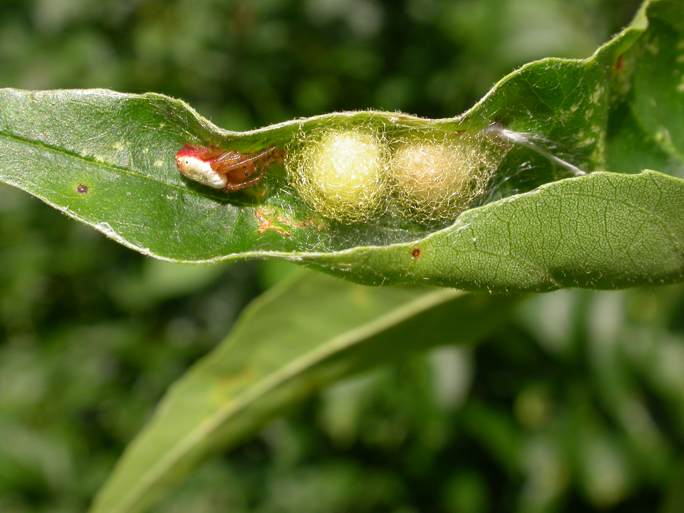 |
| Spider guarding her eggs sacs. |
Mate guarding is not uncommon in the world of spiders, though it is most prevalent in web spinning spiders. Amongst the cursorial (wandering) spiders, the usual method of mating is to find a mate, inspect them for suitability through the ritualized mating displays, and then mate if they were found suitable. This whole process can be as quick as a few minutes or as long as several hours. What makes jumping spiders unusual is that while the males go looking for females, they are often seen hanging around immature females who are physically incapable of mating!
Ok, so a bit creepy from the human perspective, but to scientists this makes perfect sense. Why? Well, in many species spider, females will only mate once in their lifetime. If a male can find a female while she is still a juvenile (and therefore incapable of mating) he can be sure he will be the first to court the female and (ideally) mate with her.
 |
| Peacock spiders (Maratus sp.) courting. The male is the colorful one on the right. |
We all know how important it is to find a good mate, but spiders seem to take this to extremes. Some males, upon finding a female, will build a nest (bivouac) by attaching lines of silk to the female's retreat. He will then proceed to follow her and "guard" her from other males until she molts to maturity, sometimes many days later. Once she has fully matured, he will begin the courting process...
Another interesting strategy some males use is to find a female's nest and court her by tapping out a species specific pattern on the walls of her nest. If she is interested, she will either wait for the male to continue and slowly proceed into the nest, or else she will come out and evaluate the male more thoroughly. If she is uninterested, the female will often run out of the nest and chase the male away.
Ok, so the male doesn't really show up with tiny bongos, but it does paint a pretty good mental image doesn't it? As with all of our posts, if you would like more info on today's topic, we would strongly encourage you to dive into the primary literature. The early work of Robert Jackson and Damian Elias are both excellent starting places for this area of research. Finally, we love hearing from our readers and encourage you to post your questions (and comments) in the comment area below. We will answer as soon as we can!
05 February 2013
Secretly Strange Salticids
Many people are aware that spiders, like virtually all invertebrates, are ectothermic (cold blooded in the vernacular) and prefer warm weather, humid environments and places with lots of readily available food. What many people are not aware of however, are the strange exceptions to each of those "rules." In this post, we will discuss a few of the weird and wonderful exceptions to the normal spidery rules that some salticids have learned to flaunt.
So cold.
Up first is the cold-defying Himalayan salticid (Euophrys omnisuperstes). While very little is known about this species, it is thought to be one of the highest known permanent residents on Earth. Living at an astonishing 6700m up, this spider can be found on the sides of Mount Everest. Never a warm place, this spider has somehow adapted to living in the extreme cold of high altitude. Whats even more amazing is that most of its food seems to be transient insects that are brought to the mountain side by the wind. For a few very nice pictures and some neat footage of E. omnisuperstes, please visit the Arkive website.
I need a drink!
Something that took me a while to really process is that not all deserts are warm. In fact, some of the driest places on Earth are very cold. Thus, this next group of spiders, those who live in very dry (arid) environments can be found in scorchingly hot places like the Arizona desert, to the arid beaches of Sweden. There are many species of salticid that have adapted to these climates, but they all have one thing in common: they have evolved a mechanism (or mehcanisms) for surviving in very harsh, dry environments. In other words, just because the popular perception of spiders decrees that spiders are mainly found in tropical and/or humid areas does not mean that they are absent from more arid regions of the world. Habronattus and Phidippus are both good genera to start researching if you would like more information on these dry climate predators.
I'm 700...
days old. Ok so its not exactly Yoda (900 years old at death), but for a salticid 700 days is practically forever. Most salticids are thought to live for one breeding season and then die (< 365 days total). However, members of the species Yllenus arenarius can 720 days for males and 750 days for females, putting the well above the average life span for a salticid.
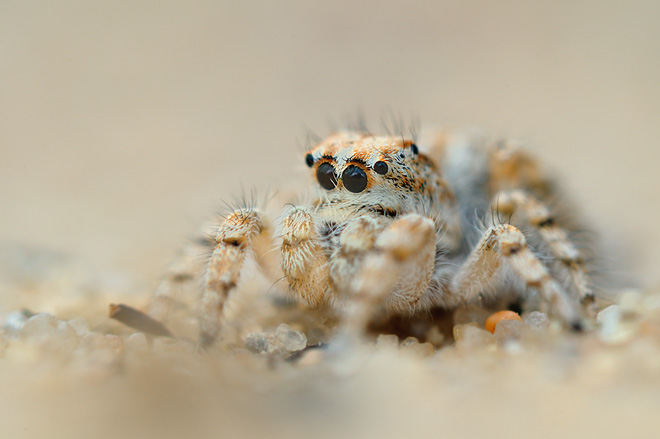 |
| http://www.digitale-naturfotos.de/galerie/images_springspinnen/big/mg2058-duenen-springspinne-yllenus-arenarius.jpg |
Silk free!
One common misconception about spiders, is that all of them build webs. Ironically, I have run into people who know that salticids do not make webs who then reached the erroneous conclusion that they do not produce silk. This is entirely untrue! Salticids make silk, like any other spider. A few even, make webs though this is very rare for the family. So if they don't make webs, but do make silk, what is it used for? Easy, bungie cords!
 |
| An artists rendering of a salticid in mid-jump. Notice the drag line laid behind the spider for safety! |
Salticids are an amazing, diverse, and above all unique group of spiders. It is no surprise that they have developed the aforementioned, and other, exceptions to the usual rules of spider behavior and adaptation. So, the next time you're out spidering, keep an eye out for salticids in unusual places. You might even find something new and unexpected!
15 January 2013
How to ID a jumping spider
While the topic has been talked about obliquely, it seems time we came out and said it directly. How, exactly, do you know if you have found a jumping spider or not? The easiest way it to simply look at its eye arrangement. If it is a jumping spider, it will have two very large eyes in the center of its face, flanked by another slightly small pair. The picture below is an excellent example of a male Phidippus audax.
 |
| http://en.wikipedia.org/wiki/File:Phidippus_audax_male.jpg |
DISCLAIMER: These rules are guidelines only! Like much of science, there will be exceptions to rules such as these, no matter how carefully crafted. Please also keep in mind that these rules, while very general, are also focused mainly on the salticids of North America. The tropics will have exceptions to most, if not all, of these rules.
Rule 1: Where was the spider found?
a) On the ground - Maybe a salticid, see rule 2
b) On a vertical surface like a wall - Maybe a salticid, see rule 3
c) In a web - probably not a salticid, but see rule 4
Rule 2: When you walk up to it, how does it move?
a) Jumps! - probably a salticid
b) Runs away very fast - most likely not a salticid
Rule 3: If you wave your hand near/over it, what does it do?
a) Turns to face your hand, or where your hand came from - Salticid!
b) Runs like heck! - probably not a salticid
Rule 4: What is the spider doing in the web?
a) Building the web - NOT a salticid
b) Feeding on another spider - Maybe a salticid, see rule 5.
Rule 5: What do the legs look like?
a) Very long and spindly - Not a jumper
b) Proportional to the body size - probably a salticid
Rule 6: If capture and put in a container (NOT airtight!) for a day or two, what does it do?
a) Builds a tiny silken sleeping bag - Salticid!
b) Builds a traditional web - not a salticid
c) Stays on the bottom of the container and cannot seem to climb the walls - not a salticid
If you think you have found a jumping spider, we encourage you to Google the animal's description. As jumping spiders are so very colorful, and often uniquely patterned, you can often find the specimen your looking for without too much trouble. One great resource for this type of searching is Bugguide.net.
Just remember, that when in doubt, always err on the side of caution and contact an expert to help you identify the spider.
03 January 2013
New year, New start!
The last few weeks have been rather slow in terms of posting. Jon and I apologize for this unexpected silence on our end. November and December became inundated with unexpected events and experiments. However, as the new year starts, new schedules are taking shape and many good things are on the way!
The good news for you dear readers is that this coming semester will feature at least one new blog post a week starting around the middle of January. Why the sudden increase in posting? Well, long story short, the book the we have been mentioning has been moved off of the back burner and will be getting large amounts of attention this semester. This means that not only will new pictures be posted frequently, but also that previews of the book's contents will begin showing up on our blog!
Jon and I are both very excited about these new developments and look forward to hearing what you, dear reader, think and things progress!
Happy New year!
The good news for you dear readers is that this coming semester will feature at least one new blog post a week starting around the middle of January. Why the sudden increase in posting? Well, long story short, the book the we have been mentioning has been moved off of the back burner and will be getting large amounts of attention this semester. This means that not only will new pictures be posted frequently, but also that previews of the book's contents will begin showing up on our blog!
Jon and I are both very excited about these new developments and look forward to hearing what you, dear reader, think and things progress!
Happy New year!
Subscribe to:
Posts (Atom)
